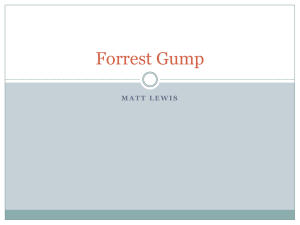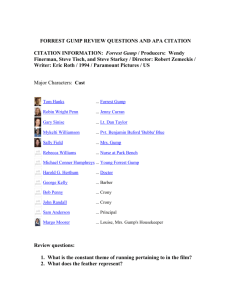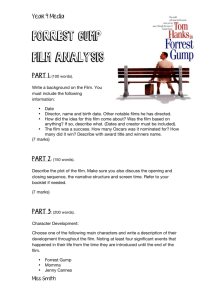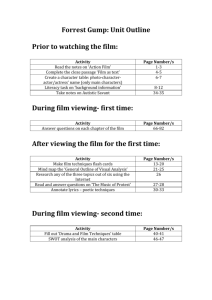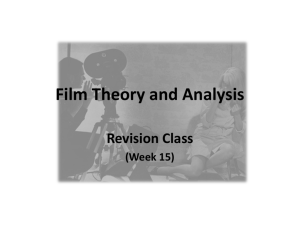Forrest Gump and its Historical Value
advertisement
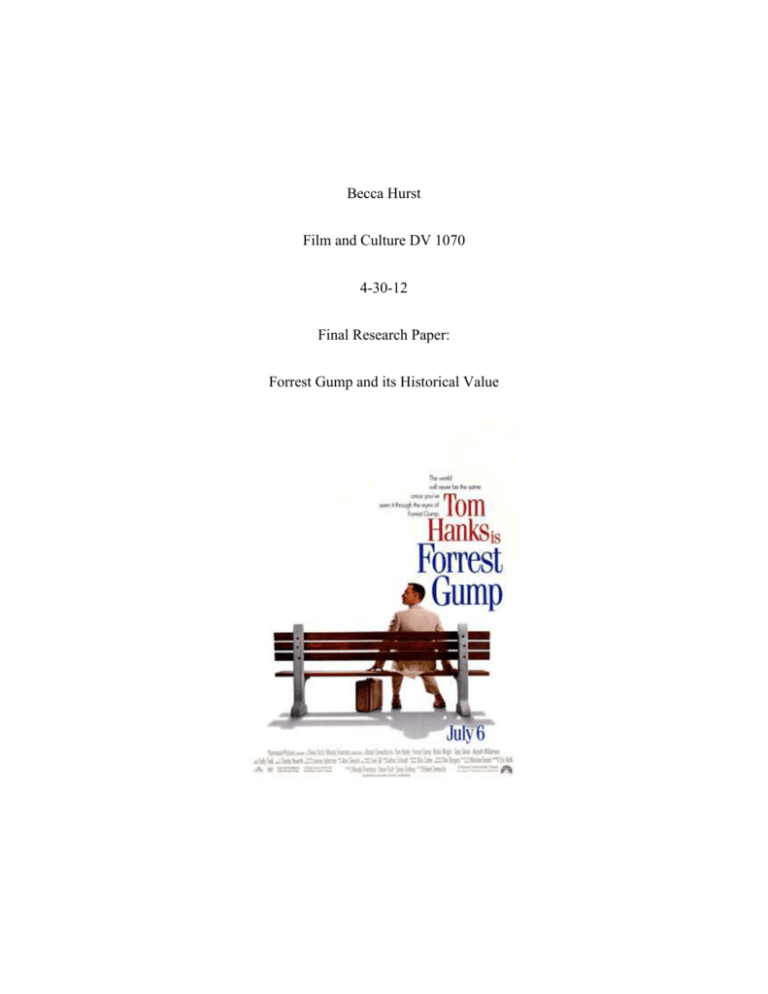
Becca Hurst Film and Culture DV 1070 4-30-12 Final Research Paper: Forrest Gump and its Historical Value Forrest Gump was directed by Robert Zemeckis and starring Tom Hanks in 1994. It addresses many issues regarding mental disabilities, war affects, and racism; just to name a few. Although all these issues are important to study and try to understand I chose to concentrate on the historical aspect and values the film presents. “This film touches on so many iconic historical elements from the 60′s, 70′s and 80′s that it has become a one of the most beloved films of all time.” (Els Malcolm). It is interesting that this film shows these major historical events through Forrest Gump, “Forrest Gump is a simple man with a low IQ but good intentions.” (The Internet Movie Database). It was important to those involved in the film that the historical elements of the film were as accurate as possible. There are many major and minor historical events throughout this film. Because these events are shown through the perception of Forrest Gump it does not go into much detail or real understanding. I believe this contributes the emotion of the film to keep the audience and Gump’s perception of the events innocent. A significant historical moment represented in Forrest Gump is in regards to the Civil Rights Movement. We witness the integration of the University of Alabama, the school in which Gump attends with a football scholarship. This event took place in 1963 when 2 black students were unable to enroll. The footage shows the black students being led in by federal troops for protection and the rally at the front doors to try and stop this from occurring. After college Forrest Gump enlists in the army and is sent to fight in the Vietnam War, a tragic war that took place from 1954 to 1975. I think it adds to the emotion of the film that the Vietnam War is not explained, you are seeing it through Gump’s point of view. “I got to see a lot of countryside. We would take these real long walks. And we were always lookin' for this guy named Charlie.” (Zemeckis, 1994). While recovering from war injuries Gump entertains himself with ping pong and becomes a national Ping Pong Player that travels to China. Although this event is greatly exaggerated in the film it is significant to know it was a ping pong team who were the first Americans to visit China since 1949. (Els Malcolm). Another minor event Forrest Gump represents is running across the country. The run was inspired by Louis Michael Figueroa who ran from New Jersey to San Francisco for the American Cancer Society. Bubba-Gump shrimping company represents the emotional connection for Gump’s war buddy, Bubba. Zemeckis continues to put historical facts into this movie, even if just for a brief moment. The portion of Gump’s life where he is running the Bubba- Gump company Hurricane Carmen enters the film. The hurricane gives Bubba-Gump free range to the shrimp and allows the business to become extremely profitable. Hurricane Carmen passed through the United States in 1974. Although Forrest Gump goes through many significant historical moments it is important to realize the journey of Gump’s true love Jenny. “Through the focus of the film is directed towards Forrest Gump, the effects of social forces are most often expressed and implied through Jenny. (Analysis of Sociologically Relevant Film: Forrest Gump). Jenny was consciously and intentionally involved in the culture movements of the 60’s. She is seen playing all the different roles expected in that time frame: hippie, anti-war movements, Black Panther Party, and precarious drug use. Forrest Gump meets a lot of historical and famous figures though-out his life. This begins as a child in the boarding house he lives in. We see Gump interacting with a young traveler, unknown at the time to be Elvis Presley. Next he receives an athletic achievement award from President John F. Kennedy. Gump is injured during The Vietnam War and earns the Medal of Honor by President Lyndon B. Johnson. After competing against the Chinese team in ping pong Gump goes to the White house for a third time to meet President Richard Nixon. Because of his many accomplishments Gump was invited to appear on the Dick Cavett Show where he appears with John Lennon. Watching Gump interact with these historical figures helps move the plot along the historical time-line. The historical content in this film would not be successful without the support of the lighting, camera affects/angles, sound/music, and costumes presented in the film. Special effects were used to insert Tom Hanks into pre-existing footage of famous people which helped the events become believable. The film did a wonderful job in tricking the audience they were watching some of Gump’s interaction and experiences off a television screen to better incorporate past footage. The film used music intended to pinpoint specific time periods portrayed on screen. "Forrest Gump" is so loaded with hit songs and eye-catching costumes that these superficial elements often supplant the narrative. (Maslin, 1994). I think it is crucial to speak of the best known scene of this film and ultimately how the film gets set in motion and ties together, “run Forrest run.” “Here, Zemeckis equate the “stars and bars” with the villains of this scene, turning Forrest into a symbol of America itself – running away from a racist past.” (Farley, 2012) It is possible this does not only represent running away from a racist past but any kind discrimination, including Gump and his low IQ. It would seem that Forrest Gump had participated in almost every possible event through the 60’s, 70’s and 80’s. “Now, because I had been a football star and a war hero and a national celebrity and a shrimpin' boat captain and a college graduate, the city fathers of Greenbow, Alabama, decided to get together and offered me a fine job.” (Zemeckis, 1994). The film shows these events through the eyes of a simple man and with the help of music, costumes, and filming techniques the viewer is able to feel the time period of events. All of the historical elements present in this film is just one aspect that makes it a beloved movie by many. Bibliography Analysis of Sociologically Relevant Film: Forrest Gump. (n.d.). Retrieved April 26, 2012, from squidoo: http://www.squidoo.com/analysis_forrest_gump Els Malcolm, C. M.-K. (n.d.). The Adaptation of Forrest Gump. Retrieved April 28, 2012, from http://forrestgump227.wordpress.com/ Farley, J. (2012, January 8). Forrest Gump (1994). Retrieved April 28, 2012, from The Film Specturm: http://thefilmspectrum.com/?p=4604#C9 Maslin, J. (1994). Forrest Gump (1994) FILM REVIEW; Tom Hanks as an Interloper in History. New York Times Review. The Internet Movie Database. (n.d.). Retrieved April 26, 2012, from IMDb.com: http://www.imdb.com/title/tt0109830/ Zemeckis, R. (Director). (1994). Forrest Gump [Motion Picture].
